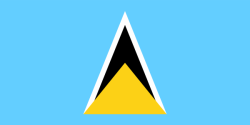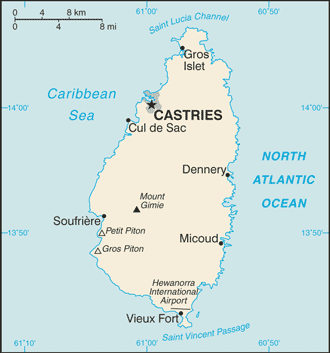Saint Lucia
Related Categories:
 Flag of Saint Lucia
Flag of Saint LuciaBlue, with a gold isosceles triangle below a black arrowhead; the upper edges of the arrowhead have a white border. |
 The Flag of Saint Lucia
The Flag of Saint LuciaBlack and white stand for the cultural influences - the white part, the white culture; the black part, the black culture - the two races living and working in unity.
www.stlucia.gov.lc/
Current and past flags.
www.fotw.us/
Saint Lucia is one of the Windward Islands, named for Saint Lucy of Syracuse. It was first visited by Europeans in about the year 1500 and first colonized successfully by France who signed a treaty with the native Carib peoples in 1660.
en.wikipedia.org/
People
St. Lucia's population is predominantly of African and mixed African-European descent, with small East Indian and European minorities. English is the official language, although many St. Lucians speak a French patois. Ninety percent of the population is Roman Catholic, a further reflection of early French influence on the island. The population of just over 162,000 is evenly divided between urban and rural areas, although the capital, Castries, contains more than one-third of the population.
History
St. Lucia's first known inhabitants were Arawaks, believed to have come from northern South America in 200-400 A.D. Numerous archaeological sites on the island have produced specimens of the Arawaks' well-developed pottery. Caribs gradually replaced Arawaks during the period from 800-1000 A.D.
Europeans first landed on the island in either 1492 or 1502 during Spain's early exploration of the Caribbean. The Dutch, English, and French all tried to establish trading outposts on St. Lucia in the 17th century but faced opposition from hostile Caribs.
The English, with their headquarters in Barbados, and the French, centered on Martinique, found St. Lucia attractive after the sugar industry developed in the 18th century. Britain eventually triumphed, with France permanently ceding St. Lucia in 1815. In 1838, St. Lucia was incorporated into the British Windward Islands administration, headquartered in Barbados. This lasted until 1885, when the capital was moved to Grenada.
Increasing self-governance has marked St. Lucia's 20th-century history. A 1924 constitution gave the island its first form of representative government, with a minority of elected members in the previously all-nominated legislative council. Universal adult suffrage was introduced in 1951, and elected members became a majority of the council. Ministerial government was introduced in 1956, and in 1958 St. Lucia joined the short-lived West Indies Federation, a semi-autonomous dependency of the United Kingdom. When the federation collapsed in 1962, following Jamaica's withdrawal, a smaller federation was briefly attempted. After the second failure, the United Kingdom and the six windward and leeward islands--Grenada, St. Vincent, Dominica, Antigua, St. Kitts-Nevis-Anguilla, and St. Lucia--developed a novel form of cooperation called associated statehood.
As an associated state of the United Kingdom from 1967 to 1979, St. Lucia had full responsibility for internal self-government but left its external affairs and defense responsibilities to the United Kingdom. This interim arrangement ended on February 22, 1979, when St. Lucia achieved full independence. St. Lucia continues to recognize Queen Elizabeth II as titular head of state and is an active member of the Commonwealth. The island continues to cooperate with its neighbors through the Caribbean Community and Common Market (CARICOM), the CARICOM Single Market and Economy (CSME), the East Caribbean Common Market (ECCM), and the Organization of Eastern Caribbean States (OECS).
www.state.gov/r/
Introduction
About
Contact
Symbols in The News
Interpret this Symbol
AAC
African
AI
Alchemy
Alphabets
Ancient
Animal Symbolism
Architecture
Art
Articles
Astrology
Baha'i
Blissymbolics
Blueprint Symbols
Buddhist
Celtic Symbols
Cemetery
Chinese Symbols
Christian
Circle
City
Codes
Color
Conlangs
Crop Circles
Danger
Da Vinci Code
Designing Logos
Dictionaries
Dreams
Education
Egyptian Symbols
Electrical
Emoticons
Find Images
Fonts
Food
Fraternity
Hamsa
Healing
Heraldry
Hermetic
Highway Signs
Hindu
History
Hobo
Holiday
Icons
iConji
Islamic
Jain Symbols
Japanese, Kanji
Jewish
Justice
Law
Literary Symbolism
Mandalas
Map
Masonic
Math, Number
Meaning of Names
Medical
Middle East
Military
Miscellaneous
Money
Music
Mythology
Native American
Playing Cards
Power
Psychology
QiQiiKhu
Reiki
Religious
Runes, Norse
Sacred Geometry
Scientific
Science Fiction
Sorority
Sports
Symbols in the News
Tattoos
ThirteenSymbols
Tree of Life
Ursprache
Videos
Visual Languages
Weather
Web Codes
Wicca
Words
Writing Systems
Braille
Coinherence
Coptic
Cuneiform
Easter Island
Etruscan
Happy Human
Hebrew
Kokopelli
Linear B
Lotus
Love Symbols
Mandorla
Moon Alphabet
Nine Pointed Star
Om
Oz
Phonetic
Scarab Beetle
Silent
Theosophy
Unifon
About
Contact
Symbols in The News
Interpret this Symbol
AAC
African
AI
Alchemy
Alphabets
Ancient
Animal Symbolism
Architecture
Art
Articles
Astrology
Baha'i
Blissymbolics
Blueprint Symbols
Buddhist
Celtic Symbols
Cemetery
Chinese Symbols
Christian
Circle
City
Codes
Color
Conlangs
Crop Circles
Danger
Da Vinci Code
Designing Logos
Dictionaries
Dreams
Education
Egyptian Symbols
Electrical
Emoticons
Find Images
Fonts
Food
Fraternity
Hamsa
Healing
Heraldry
Hermetic
Highway Signs
Hindu
History
Hobo
Holiday
Icons
iConji
Islamic
Jain Symbols
Japanese, Kanji
Jewish
Justice
Law
Literary Symbolism
Mandalas
Map
Masonic
Math, Number
Meaning of Names
Medical
Middle East
Military
Miscellaneous
Money
Music
Mythology
Native American
Playing Cards
Power
Psychology
QiQiiKhu
Reiki
Religious
Runes, Norse
Sacred Geometry
Scientific
Science Fiction
Sorority
Sports
Symbols in the News
Tattoos
ThirteenSymbols
Tree of Life
Ursprache
Videos
Visual Languages
Weather
Web Codes
Wicca
Words
Writing Systems
Braille
Coinherence
Coptic
Cuneiform
Easter Island
Etruscan
Happy Human
Hebrew
Kokopelli
Linear B
Lotus
Love Symbols
Mandorla
Moon Alphabet
Nine Pointed Star
Om
Oz
Phonetic
Scarab Beetle
Silent
Theosophy
Unifon
